Continued emphasis on energy efficiency adds to the importance of controlling and monitoring the large number of power automation devices deployed at field sites with supervisory control and data acquisition (SCADA) systems.
As most of these devices, including power meters, UPSs, smart relays, and ATS controllers, support Modbus RTU protocols because of its simplicity, interoperability can be an issue since SCADA systems usually employ Ethernet-based protocols such as Modbus TCP. In power monitoring applications, apart from the challenge of converting Modbus RTU/ASCII to Modbus TCP, the deployment of devices on a large scale also adds to SIs' woes.

To overcome the interoperability issue, gateways that easily convert Modbus TCP to Modbus RTU, and vice versa, are the most cost-effective solution. In addition, if you want to address the large-scale deployment of devices as well, then Modbus gateways with multiple serial ports (8 or 16 ports, for example) fit the solution best.
Unnecessary Holdups
In large-scale critical applications where every millisecond counts, SCADA systems cannot afford to wait for field devices to send their response to simultaneous data acquisition requests one by one. It is not uncommon for SCADA systems to experience a huge time gap between reading the first device and the last one, because transparent mode communication-the standard in the Modbus gateway market-deals with the simultaneous requests and responses one by one. Reduced scan times, undeniably, will optimize operations and ease SIs' workloads.
The Beauty of Agent Mode
Building a new system is one way to achieve reduced scan times. The key to the success of a newly designed system is a gateway that boosts a SCADA system's performance, increases the flexibility of a SCADA program's design, and enables easy configuration. Gateways that support agent mode communication and have a high multiport density can accomplish these goals. Agent mode, designed to overcome the shortcomings of transparent mode, allows each side of the gateway to conduct communication independently from each other. On the one side, each serial port of the gateway acts as a Modbus RTU master actively polling the Modbus RTU slaves such as power meters; on the other side, the gateway functions as a Modbus TCP server, polled by the SCADA system. An all-important feature of gateways that support agent modes is an internal memory that facilitates seamless data retrievals.

Agent mode communication presents several advantages. From a SCADA system's vantage point, its scan time is much faster than transparent mode communication. Only the duration of the Modbus TCP request and Modbus TCP response make up the scan time as there is no need for the SCADA system to wait on the Modbus RTU leg of the polling process.
Another benefit is that agent mode allows all the data generated by the devices to be transferred in a few packets. From the SCADA system's vantage point, the gateway represents a data bank that delivers the requested information. In its Modbus RTU capacity, each serial port of the gateway actively polls different meters to retrieve data from their various registers. The collected data is continuously stored in the gateway's internal memory. It only requires a TCP channel to transfer the requested data in a few packets instead of setting tons of commands in SCADA, which make configuration more complex. For any SI, easy integration is always a high priority. In agent mode, the gateway in its RTU master capacity can implement many Modbus commands. In order to save time with configuration, some gateway brands support comma-separated value (CSV) files, which can be easily configured and imported into the gateway by using MS Excel. This is definitely a great benefit, especially for deployments of a large scope.
Moxa's Solutions
To learn more about the best option to reduce scan times by retrofitting your system, download our white paper: How to Optimize SCADA Systems through a Modbus Gateway.
If you want more information about our solutions, download our solutions brochure.